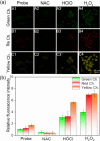A Smart Triple-Signal Fluorescent Probe for Real-Time Differential Imaging of HClO, H2O2, and Their Mixture in Diabetic Models
- PMID: 41169451
- PMCID: PMC12569950
- DOI: 10.1021/cbmi.5c00040
A Smart Triple-Signal Fluorescent Probe for Real-Time Differential Imaging of HClO, H2O2, and Their Mixture in Diabetic Models
Abstract
Diabetes is a complex metabolic disorder characterized by persistent hyperglycemia, which causes damage to multiple target organs and triggers a range of complications. Oxidative stress, driven by reactive oxygen species (ROS) such as hypochlorite (HClO) and hydrogen peroxide (H2O2), plays a crucial role in the onset and progression of diabetes and its associated complications. Therefore, the simultaneous and differential detection of HClO, H2O2, and their mixture is essential for accurately assessing oxidative stress status and understanding their synergistic roles in disease progression. In this study, we present a triple-signal fluorescent probe, probe 1, designed to simultaneously and selectively detect HClO, H2O2, and their combination with high specificity and sensitivity. The probe emits three distinct fluorescence signals, enabling precise real-time visualization of oxidative stress dynamics in complex biological systems. Probe 1 has been successfully applied to track both exogenous and endogenous levels of HClO and H2O2 in living cells and zebrafish models. Furthermore, its efficacy has been demonstrated in diabetic mouse models, where it facilitates the spatial and temporal monitoring of oxidative stress across different organs. These findings underscore the potential of probe 1 as a powerful tool for advancing the understanding of oxidative stress mechanisms and developing targeted therapeutic strategies for diabetes and related diseases.
Keywords: Diabetes; Fluorescent Probe; Hydrogen Peroxide; Hypochlorite; Oxidative Stress.
© 2025 The Authors. Co-published by Nanjing University and American Chemical Society.
Figures






References
-
- Wang W., Wong N.-K., Bok S.-L., Xu Y., Guo Y., Xu L., Zuo M., St Croix C. M., Mao G., Kapralov A., Bayir H., Kagan V. E., Yang D.. et al. Visualizing Cardiolipin In Situ with HKCL-1M, a Highly Selective and Sensitive Fluorescent Probe. J. Am. Chem. Soc. 2023;145:11311–11322. doi: 10.1021/jacs.3c00243. - DOI - PMC - PubMed
LinkOut - more resources
Full Text Sources
